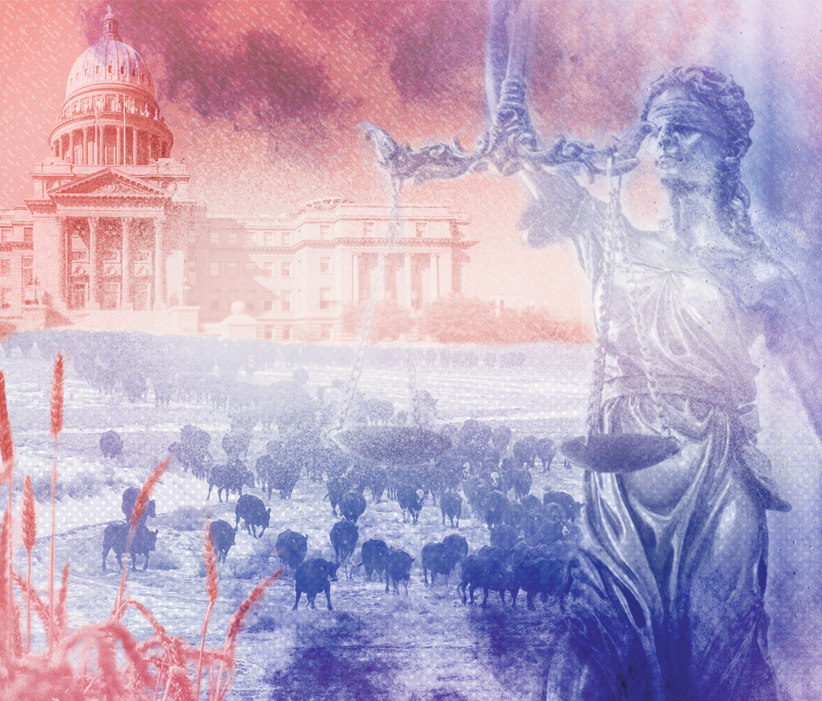The Idaho 2024 legislative session has concluded, with some of the bills and resolutions relating to agriculture recapped here. To access the full details or to learn how your legislators voted, visit the Idaho Legislature website.
H0468 – Rangeland Improvement Act
This legislation directs the Idaho Department of Agriculture to seek funding for and carry out grazing improvement projects statewide through the Grazing Board Central Committee which was originally created by the Taylor Grazing Act of 1934 and reauthorized by the Federal Land Policy Management Act (FLPMA).
Update: Signed by governor; effective July 1, 2024
H608a – Ag Protection Area
This legislation provides landowners with an additional option when considering protecting agricultural land in the state. The legislation adds a new chapter to the Idaho Local Land Use Planning Act that would provide the legislative authority for county governments to receive applications from willing landowners to establish a land use designation, known as an Agricultural Protection Area. The process to review and consider applications is outlined in the legislation.
Update: Signed by governor; effective July 1, 2024
S1342 – Grazing leases
This legislation extends grazing leases to a potential maximum length of 40 years for state endowment lands. Currently, grazing leases have a maximum length of 20 years. Extension of the lease length would create greater predictability for those obtaining a grazing lease because they would be able to plan how they handle and care for the lease over a longer term. Additionally, it would provide longer-term consistency for the Idaho Department of Lands in creating constant revenue for the endowment fund from grazing leases.
Update: Signed by governor; effective July 1, 2024
H0592 – Livestock Depredation
This bill establishes a fund for conflict prevention and livestock depredation by grizzly bears and wolves. This fund provides compensation to livestock owners and producers who have experienced livestock loss. The Idaho State Department of Agriculture, in consultation with the Department of Fish and Game and the Office of Species Conservation, will manage the fund and will be the authorized agency for compensation to livestock owners and producers. The annual appropriation will be $225,000, containing $150,000 dedicated to livestock depredation and $75,000 dedicated to conflict prevention.
Update: Signed by governor; effective July 1, 2024
H0474 – Pesticides, damage, false claims
This legislation creates a new section of Idaho Code, 22-3417B, relating to false reporting of pesticide and chemigation damage claims. In recent years, applicators have been subjected to an increasing number of damage claims that have been determined to be false by investigators. This legislation creates a misdemeanor criminal penalty for these types of false claims.
Update: Signed by governor; effective July 1, 2024
H0467 – Irrigation, special assessments
Excessive use fees and special assessments have been tools that groundwater districts have used to provide proper incentives to water users to follow their water rights and mitigation plans. Over time, the statutory limit of $100 per acre-foot of excess water use has lost effect due to inflation and increased commodity prices. This legislation, requested by groundwater districts, brings that limit up to current times and provides a disincentive to overuse of irrigation water.
Update: Signed by governor; effective July 1, 2024
H0549 – Chemigation
This legislation will streamline requirements for chemigation applicators. Idaho law currently aligns licensing for all pesticide application types with federal regulation, even though the federal regulation does not mandate chemigation licensing. This legislation will decouple chemigation from the federal licensing structure and allow Idaho to implement a state structure developed with our farmers and applicators.
Update: Signed by governor; effective March 18, 2024
H0712 – Estray livestock
Amends Idaho code to update the current statues related to estray livestock as well as create an infraction for instances when operators do not recover their estray livestock following a three-day notice period for a county sheriff or state brand inspector.
Update: Signed by governor; effective April 1, 2024
S1322 – Invasive species
Amends and adds to existing law to provide requirements for launch and transport of conveyances and to provide that a portion of annual revenue deposited in the invasive species fund may be made available to counties, cities and other local entities for certain equipment and supplies.
Update: Signed by governor; effective July 1, 2024
SB 1372 – Appropriations, Department of Agriculture
A key funding bill to support the state’s fight against invasive quagga mussels in Idaho waterways. The increase in funding will go toward the ongoing prevention and monitoring of invasive species and future preparedness for ISDA's rapid response. In addition, the budget authorized two additional dairy inspectors to support the dairy industry and an additional state veterinary position in south-central Idaho.
Update: Signed by governor; effective July 1, 2024
S1339 – Rights-of-way
This legislation makes updates to certain sections of the law regarding ditches. It combines related provisions into one place, removes outdated rules and makes things clearer based on recent court decisions and current practices. Specifically, it includes laterals and drains in the laws about ditch rights-of-way (ROW), clarifies when landowners are aware of these rights-of-way, defines maintenance responsibilities in one statute instead of several, removes old provisions about crossing ditches and building bridges over them, and incorporates recent court interpretations about permissions, encroachments and "self-help" provisions.
Update: Signed by governor; effective July 1, 2024
S1341 – Eastern Snake, Groundwater
Defines the area in which the director of the Department of Water Resources is authorized to administer groundwater along the Eastern Snake Plain Aquifer.
Update: Signed by governor; effective July 1, 2024




.jpg?t=1687979285&width=640)

.jpg?height=auto&t=1713304395&width=285)
.jpg?height=auto&t=1713198780&width=285)
